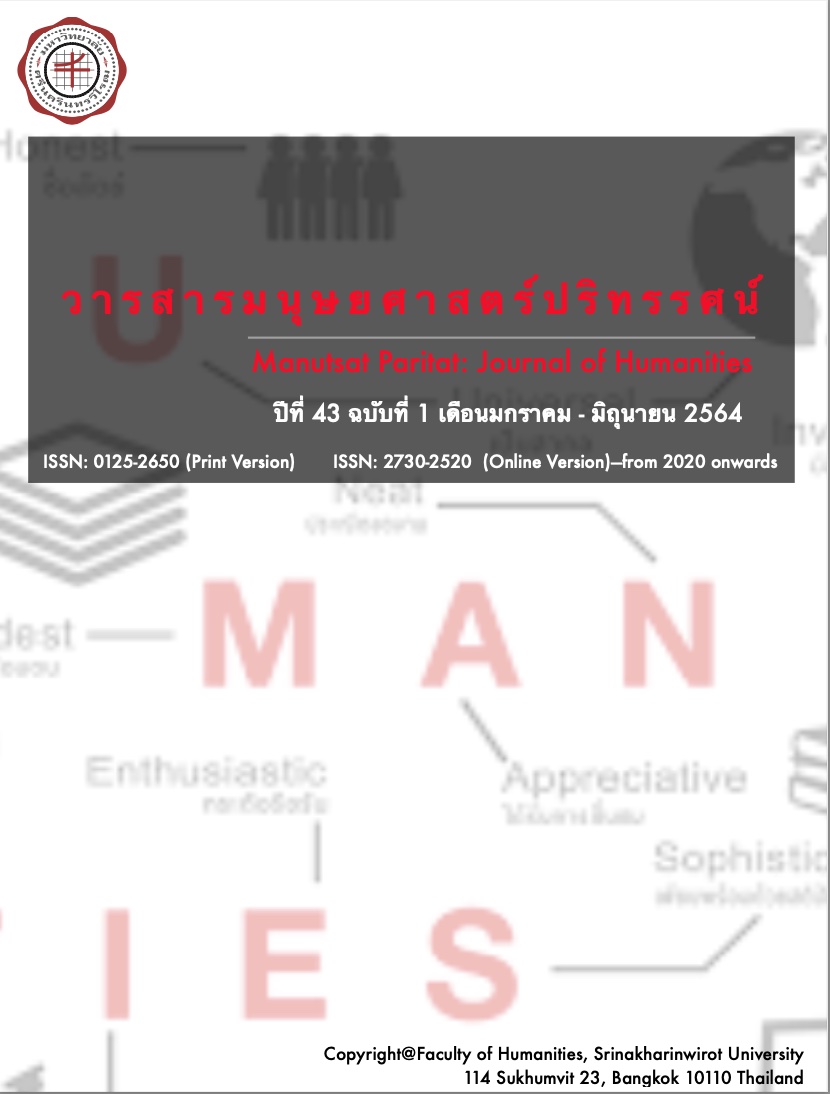ปัจจัยทางจิตและสังคมที่สัมพันธ์กับภูมิคุ้มกันทางใจในการโดนกลั่นแกล้งรังแกบนโลกออนไลน์ของนักเรียนชั้นมัธยมศึกษาตอนปลาย
Main Article Content
บทคัดย่อ
การวิจัยครั้งนี้มีจุดประสงค์ 1) เพื่อศึกษาความสัมพันธ์ของปัจจัยทางจิต ได้แก่ การเห็นคุณค่าในตนเอง การมองโลกในแง่ดี และปัจจัยทางสังคม ได้แก่ การสนับสนุนทางสังคมจากครอบครัว โรงเรียน และเพื่อน ที่สัมพันธ์กับภูมิคุ้มกันทางใจในการโดนกลั่นแกล้งรังแกบนโลกออนไลน์ และ 2)เพื่อศึกษาอำนาจในการทำนายของปัจจัยทางจิตและปัจจัยทางสังคม ที่มีต่อการมีภูมิคุ้มกันทางใจในการโดนกลั่นแกล้งรังแกบนโลกออนไลน์ของนักเรียนชั้นมัธยมศึกษาตอนปลาย กลุ่มตัวอย่างในการวิจัย คือ นักเรียนชั้นมัธยมศึกษาตอนปลาย จำนวน 300 คน ซึ่งได้มาโดยการสุ่มแบบชั้นภูมิ การเก็บรวบรวมข้อมูลใช้แบบวัดที่มีลักษณะเป็นมาตรประเมินค่า 6 ฉบับ ได้แก่ แบบวัดการเห็นคุณค่าในตนเอง การมองโลกในแง่ดี แบบวัดการสนับสนุนทางสังคมจากครอบครัว โรงเรียน และเพื่อน และแบบวัดการมีภูมิคุ้มกันทางใจในการโดนกลั่นแกล้งรังแกบนโลกออนไลน์และวิเคราะห์ข้อมูลโดยใช้การวิเคราะห์สหสัมพันธ์แบบเพียร์สันและการวิเคราะห์ถดถอยพหุคูณแบบปกติ
ผลการวิจัยพบว่า 1) ตัวแปรต้นทุกตัวมีความสัมพันธ์กับภูมิคุ้มกันทางใจในการโดนกลั่นแกล้งรังแกบนโลกออนไลน์อย่างมีนัยสำคัญทางสถิติที่ระดับ .01 และ 2) ปัจจัยทางจิต ได้แก่ การเห็นคุณค่าในตนเองและการมองโลกในแง่ดี ปัจจัยทางสังคม ได้แก่ การสนับสนุนทางสังคมจาก ครอบครัว โรงเรียน และเพื่อน สามารถร่วมกันทำนายการมีภูมิคุ้มกันทางใจในการโดนกลั่นแกล้งรังแกบนโลกออนไลน์ของนักเรียนระดับชั้นมัธยมศึกษาตอนปลายได้อย่างมีนัยสำคัญทางสถิติที่ระดับ .05 คิดเป็นร้อยละ 46.8 ตัวแปรที่มีความสำคัญมี 4 ตัวแปร ได้แก่ การเห็นคุณค่าในตนเอง การมองโลกในแง่ดี การสนับสนุนทางสังคมจากเพื่อน การสนับสนุนทางสังคมจากครอบครัว
Article Details
การคัดลอก ตีพิมพ์ซ้ำ การเผยแพร่ซ้ำบทความใด ๆ ก็ตามที่ปรากฎอยู่ในวารสารมนุษยศาสตร์ปริทรรศน์ ถือเป็นการละเมิดสิทธิในความเป็นเจ้าของของบทความดังกล่าวที่ปรากฎอยู่ในวารสารมนุษยศาสตร์ปริทรรศน์ กรุณาติดต่อ MPJHthaijo@gmail.com เพื่อขออนุญาตคัดลอก ตีพิมพ์ซ้ำ เผยแพร่ซ้ำบทความใด ๆ ก็ตามที่ปรากฎอยู่ในวารสารมนุษยศาสตร์ปริทรรศน์ ลงในสื่อสิ่งพิมพ์ต่าง ๆ หรือสื่อออนไลน์
เอกสารอ้างอิง
ในจังหวัดนครปฐม. วิทยานิพนธ์ ศศ.ม. (จิตวิทยาชุมชน). นครปฐม: บัณฑิตวิทยาลัย มหาวิทยาลัย
ศิลปากร.
จิตรภานุ ดำสนวน. (2560). ปัจจัยที่เป็นตัวพยากรณ์ภูมิคุ้มกันทางใจของวัยรุ่นในอำเภอหนองกี่ จังหวัดบุรีรัมย์.
วิทยานิพนธ์ พธ.ม. (พุทธจิตวิทยา). พระนครศรีอยุธยา: มหาวิทยาลัย มหาจุฬาลงกรณ์ราชวิทยาลัย.
ชาญวิทย์ พรนภดล; ศิริสุดา ลดาวัลย์ ณ อยุธยา; ตวงพร สุรพงษพิวัฒนะ; ชดาพิมพ์ ศศลักษณานนท์; และปาฏิโมกข์
พรหมช่วย. (2552). การศึกษาหาปัจจัยป้องกันการติดเกมในเด็กและวัยรุ่น. กรุงเทพฯ: สำนักงานคณะกรรมการวิจัยแห่งชาติ.
ไพศาล แย้มวงษ์. (2555). การศึกษาการสนับสนุนทางสังคมที่ส่งผลต่อความพึงพอใจในชีวิตของนักศึกษา
มหาวิทยาลัยธรรมศาสตร์. ปริญญานิพนธ์ กศ.ม. (จิตวิทยาการแนะแนว). กรุงเทพฯ: บัณฑิตวิทยาลัย
มหาวิทยาลัยศรีนครินทรวิโรฒ.
ฤติมา รักษารักษ์; และ งามลมัย ผิวเหลือง. (2558). อิทธิพลของการสนับสนุนทางสังคม การเห็นคุณค่าใน
ตนเองและการควบคุมตนเองที่มีต่อความหยุ่นตัวของนิสิตรอพินิจ. วิทยานิพนธ์ วท.ม. (สาขาวิชา
จิตวิทยาชุมชน). กรุงเทพฯ: คณะสังคมศาสตร์ มหาวิทยาลัยเกษตรศาสตร์.
มะลิวรรณ วงษ์ขันธ์, พัชรินทร์ นินทจันทร์, และโสภิณ แสงอ่อน. (2558). ปัจจัยที่มีความสัมพันธ์กับความแข็งแกร่งใน
ชีวิตในวัยรุ่น. วารสารการพยาบาลจิตเวชและสุขภาพจิต. 29(1): 57-75.
วิมลทิพย์ มุสิกพันธ์; ศิวพร ปกป้อง; นันทนัช สงศิริ; และปองกมล สุรัตน์. (2552). พฤติกรรมการข่มเหงรังแกผ่าน
โลกไซเบอร์ของเยาวชนไทยเขตกรุงเทพมหานคร: รายงานผลการสำรวจประชามติครั้งที่ 3.
กรุงเทพฯ: ปัญญาสมาพันธ์เพื่อการวิจัยความเห็นสาธารณะ แห่งประเทศไทย.
ศรีเรือน แก้วกังวาล. (2540). จิตวิทยาพัฒนาการชีวิตทุกช่วงวัย. พิมพ์ครั้งที่ 7. กรุงเทพ: มหาวิทยาลัยธรรมศาสตร์.
สุคนธ์จิต อุปนันชัย. (2556). อิทธิพลของการสนับสนุนทางสังคม การเห็นคุณค่าแห่งตน และการรับรู้
ความสามารถของตนที่มีต่อความยืดหยุ่นทางอารมณ์ของนักเรียนในจังหวัดนนทบุรี. ปริญญานิพนธ์
กศ.ม. (จิตวิทยาพัฒนาการ). กรุงเทพฯ: บัณฑิตวิทยาลัย มหาวิทยาลัยศรีนครินทรวิโรฒ.
อรพินทร์ ชูชม; สุภาพร ธนะชานันท์; และทัศนา ทองภักดี. (2554). รายงานการวิจัยฉบับที่ 137 เรื่อง ปัจจัยเชิง
เหตุและผลของภูมิคุ้มกันทางจิตของเยาวชน. กรุงเทพฯ: สถาบันวิจัยพฤติกรรมศาสตร์ มหาวิทยาลัย
ศรีนครินทรวิโรฒ.
Agatston, P.W.; Kowalski, R.; & Limber, S. (2007). Students' Perspectives on Cyber Bullying.Journal of
Adolescent Health. 41: 59-60.
Hair, J.F.; Black, W.C.; Babin, B.J.; & Anderson, R.E. (2010). Multivariate Data Analysis. Seventh Edition.
Prentice Hall. Upper Saddle River: New Jersey.
Dooley, J. J.; Pyżalski, J.; & Cross, D. (2009). Cyberbullying versus Face-to-Face Bullying: A Theoretical
and Conceptual Review. Journal of Psychology. 217(4): 182–188.
Patchin, Justin W.; & Hinduja, Sameer. (2012). Cyberbullying Prevention and Response: Expert
Perspectives. New York: Routledge.
Rosenberg, M. (1965). Society and the Adolescent Self-image. Princeton. NJ: Princeton University Press.
................. 1981. "The Self-Concept: Social Product and Social Force." Pp. 593-624 in Social Psychology:
Sociological Perspectives, edited by M. Rosenberg and R.H. Turner. New York: Basic.
Scheier, M. F.; & Carver, C.S. (1985). Optimism Coping and Health: Assessment and Implications of
Generalized Outcome Expectancies. Retrieved Jan 20, 2021,
from https://doi.org/10.1037/0278-6133.4.3.219
Smith, P. K.; et al. (2008). Cyberbullying; Its Nature and Impact in Secondary School Pupils. Journal of
Child Psychology and Psychiatry. 49(4): 376-385.
Weber, N.L.; & Pelfrey, W.V. Jr. (2014). Cyberbullying: Causes Consequences and Coping Strategies.
Texas: LFB Scholarly Publishing.
World health Organization. (2015). Preventing Youth Violence: An Overview of the Evidence. Retrieved,
September 24, 2017, from http://apps.who.int/iris/bitstream/10665/181008/1/9789241509251_eng.pdf.


